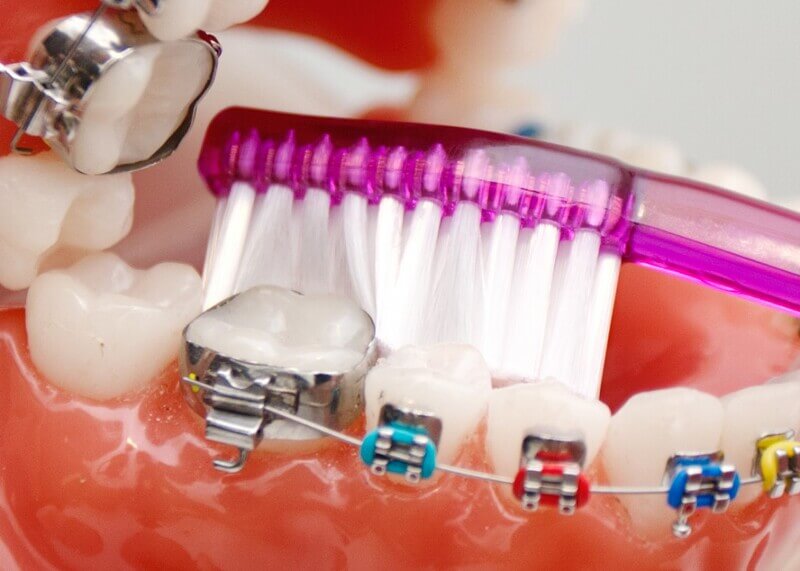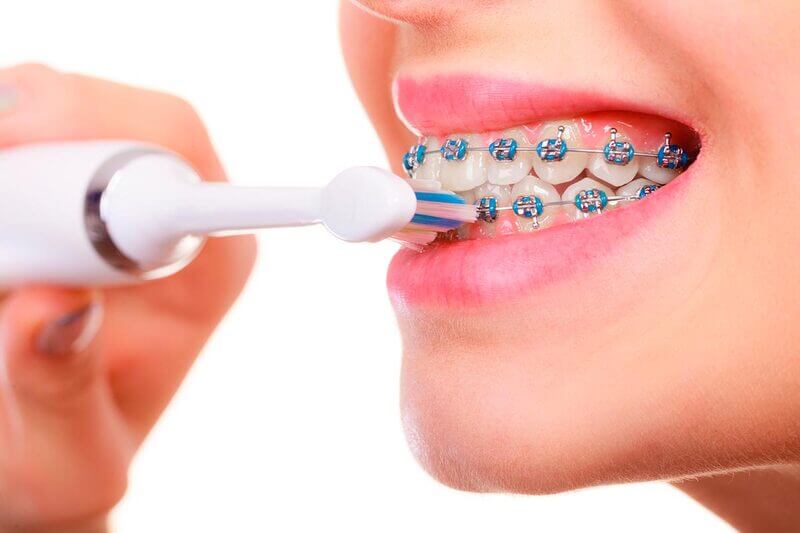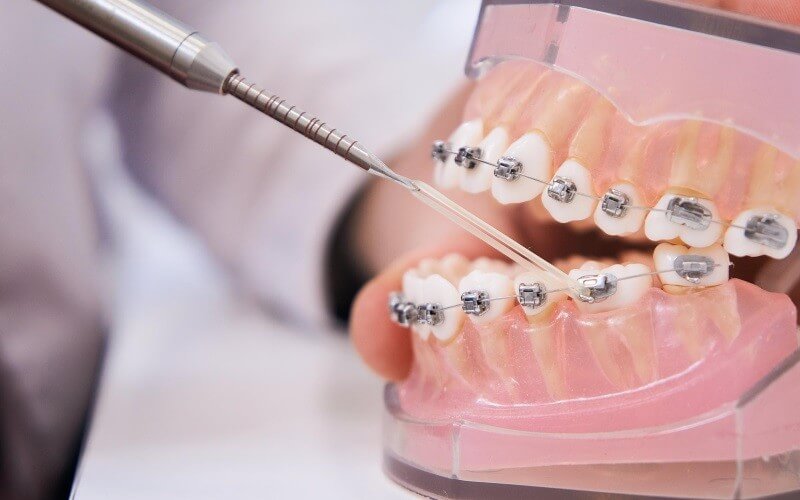How to Take Care of Braces

Contents:
After getting the braces, you need to use particular tools, such as brushes, irrigators, and interdental brushes. They help gently and delicately clean the spaces between teeth. However, poor oral hygiene can lead to the development of tooth decay and periodontal disease. Therefore, brushing your teeth with braces on should be more thorough.
Brace Care Products

The teeth alignment is carried out using orthodontic appliances. A simple toothbrush is not enough for brace care. The oral hygiene routine consists of several stages. This will require:
- V-Shaped bristles toothbrushes. An end-tufted brush is recommended for brace care.
- Interdental brushes. This is a type of brush supplied with a long handle. They are designed for cleaning between teeth and between the wires of dental braces. The brush has a service life of approximately two weeks. It is typically supplied with several disposable heads in the kit.
- Floss (dental floss). It removes trapped food between teeth spaces. There are four types of floss – flat, round, tape and super floss used to clean dentures and braces. The waxed threads with fluoride reduce the risk of cavities. It is recommended to floss your teeth after a meal and a snack.
- Portable and stationary irrigators. These are the devices releasing a powerful stream of water. This helps to remove food debris and plaque not only between teeth. In addition, irrigators help clean hard-to-reach areas that toothbrushes and interdental brushes cannot reach.
- Rinses. When wearing braces, choose products without dyes and alcohol. Cleansing foams are suitable. They are used in case the toothbrush is not an option. Foams do not contain abrasive particles, alcohol; they should not be rinsed with water. The product is distributed over the gums, held for 30 seconds, and then spit out. They are not a substitute for a thorough tooth brushing.
- Wax and silicone for braces. The products are applied after brushing the teeth and brace elements. Then dry it up, pinch off a little wax, roll it into a ball and attach it to a lock or arc, squeezing slightly. This protects the brace components and mucous membranes from damage and reduces pain.
While wearing braces, you can take any toothpaste without the whitening effect, as it contains abrasive components that can damage teeth, ceramic coatings and chemically destroy the attachment points.
Braces Cleaning Routine
How do braces work: they correct the position of the teeth. The appliances consist of many small elements. Vestibular braces are attached on the outside of the teeth, lingual braces on the inside, making it more challenging to care for. In addition, the food debris, plaque and tartar are accumulated between the components, on the locks and under the wires.
The braces are cleaned in a circular motion. In addition to toothbrushes, interdental brushes are used as well. They gently clean the interdental space and structural elements under the wires. The procedure is performed after the initial cleaning with toothpaste. The braces need to be cleaned in several stages.
| Cleaning Tools and Products for Brace Care | Features |
| Toothpaste | Choose a multifunctional one that will remove plaque, tartar, reduce inflammation and prevent the deposits. The paste must contain calcium and fluoride. Preference is given to products with plant enzymes. |
| Interdental brush | It attaches to a long metal handle with nylon fibres. The head can be tapered or cylindrical, slightly angled. After just getting the braces put, choose a soft or medium brush. The interdental brush is held to the teeth at a right angle for cleaning, moving it slowly. First, the interdental space is cleaned, then the sides. Finally, to clean the arc of the structure, the brush is held parallel to it, making up and down movements. |
| Irrigator | They are used for hard-to-reach places near braces and behind the wires. They are especially effective for lingual appliances that are difficult to clean with brushes and interdental brushes. Irrigators do not have to be used daily; it is enough to use them additionally 2-3 times a week. In addition, the devices have special orthodontic tips. Before rinsing, a disinfectant solution or boiled water is poured into the reservoir. The liquid is directed from top to bottom on the upper jaw and from bottom to top on the lower jaw; the pressure is increased gradually. |
Floss your teeth after every snack. There is special stiffened-end dental floss that does not break when in contact with the appliance and does not wear down. Cleansing is carried out with progressive movements. First, the thread is pulled between the teeth and, holding it with both hands, gently and carefully move it so as not to damage the gum and not to hook the structural elements.
Toothbrushes for Braces

Simple V-shaped bristle toothbrushes are suitable for cleaning braces. You can use electric and ultrasonic brushes. It does not rub the teeth and structural elements; it is enough to move the brush and hold it near each tooth for a few seconds. There are two types of toothbrushes for braces:
1. V-shaped. It differs from the usual one by the uneven length of bristles. They are of standard height around the edges and shorter in the centre. When moving, the bristles adhere tightly to all structural elements. They clean the plaque from the locks and the wire. It is recommended to choose brushes with soft bristles and a small head.
2. Mono-beam. It is used for spot cleaning of braces, teeth and gaps between them. This design has a thin base with a small round head at the end. The bristles length is up to 1cm. They clean even hard-to-reach places.
When choosing a toothbrush, the hardness of the bristles is essential. In addition, it is recommended to choose models with rubber grips so that they do not slip in hand.
Dental Hygiene with Braces

Dental hygiene with braces: after every meal. It is necessary to exclude sticky and staining food. Food with a rigid structure should be chopped; otherwise, it can damage the appliance. Food should be warm, not too hot and not too cold. After each meal, you need to rinse your mouth. There are the following stages of hygiene routine:
- brushing teeth using toothpaste for 3-5 minutes, 10 seconds per tooth;
- brushing the appliance using an interdental brush;
- rinsing with mouthwash for 20 seconds;
- using an oral irrigator to clean the teeth and braces.
Taking care of braces requires professional cleaning. It is recommended to perform it every 3-4 months. Ultrasound removes plaque and tartar well. However, the disadvantage of the method is that it cannot be applied in the areas close to braces components.
Therefore, the Air Flow device will be most effective. This is a handpiece nozzle through which a soda solution is supplied under high pressure helping to clean the areas under the wires, near the gums, and around the braces.
First, the teeth are treated with a dye that accumulates on plaque or tartar. This helps to direct the nozzle of the instrument to the required area. Then the teeth are treated with a soda solution under pressure. Plaque is removed gently, without damaging tissues and orthodontic components.
Proper care will help prevent diseases and inflammation of the oral cavity. In case of insufficient hygiene after removing the appliance, white spots may remain on the teeth in the places where the braces are attached. Therefore, in addition to daily oral hygiene, it is recommended to carry out professional cleaning every three months.

